Av Chris Grinter, den 1 juli, 2010 Och nu till det ännu mer sällan återkommande serie, vox populi! För de utan ärrbildning gymnasiet minnen av latin klass (förskyllan min lärare) Jag ska ta dig upp till hastigheten – titeln betyder ungefär att “folkets röst”. Här är en annan gammal e-post som jag har sparat. Det är ett 100% real message, but of course I have redacted the real names and addresses to protect the innocent. Enjoy! I also highly encourage submissions of your own-
Winter 2008:
“Hej, I’m so glad I found you. Nu, I hope you can help me. 1982, while camping at an old gold mining camp in the Mendocino National Forest I was bitten by a large brown spider. It took three days for the venom to pass through my system. On day three I was 95% blind, the bite swelled to a large grotesquely deep red bump on my arm. I’ll never forget the 12 hours the venom attacked me. The price I payed to survive this spiders venom was…….to loose absolutely all my body fat. I spoke with a doctor from Santa Rosa by phone from a friends place in (some small CA town). He knew about this spider and couldn’t believe I suvived the venom when I told him I lost all my body fat. He also told me it was impossible for someone to survive loosing all their body fat in 12 timmar. I reminded him that this was an impossible situation. He told me that this spider is being kept from the public. I believe this spider came from China or Russia. These spiders don’t share anything with other Cali spiders. They have big bodies and short stout legs. The female that bit me was about 4 inch’s and, had 5 males. Four years later, while living in the Hayward hills, I couldn’t believe my eyes, running across the floor, another one. This spider was about 6 inch’s. I know these spiders don’t climb walls or spin webs. They build nest’s, and obtain 4-5 males to protect her and find food. The female never leave’s the nest except…………when a larger female drives her out and, kills her males. This is when people are bitten by this spider, as she runs around looking for another nest. Bites are very uncommon. I wondered………….how big was the female that drove that 6 inch from her nest. And………….how big do they get. Can I find this spider on display at (your museum)? Is it possible to find all the information their is on this very dangerous spider?”
Continue reading Vox Populi, volym II
Av Chris Grinter, on June 26th, 2010 Welcome to volume eight of the inconsistently reoccurring series, Genius av Press. I came across this article recently regarding an endemic Puerto Rican butterfly. Who can tell me exactly why this report is misleading? It may be a little trickier than the standard GOP (I suggest discarding any previously associated acronyms with those letters). Hint, just telling me the butterfly in the picture is from Malaysia is not the answer I’m looking for!
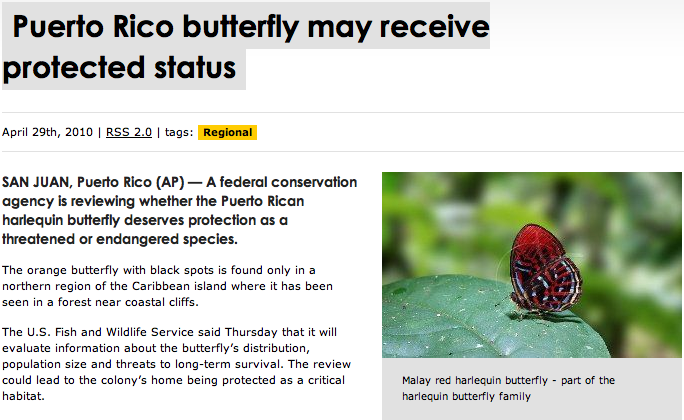
Av Chris Grinter, den 23 juni, 2010 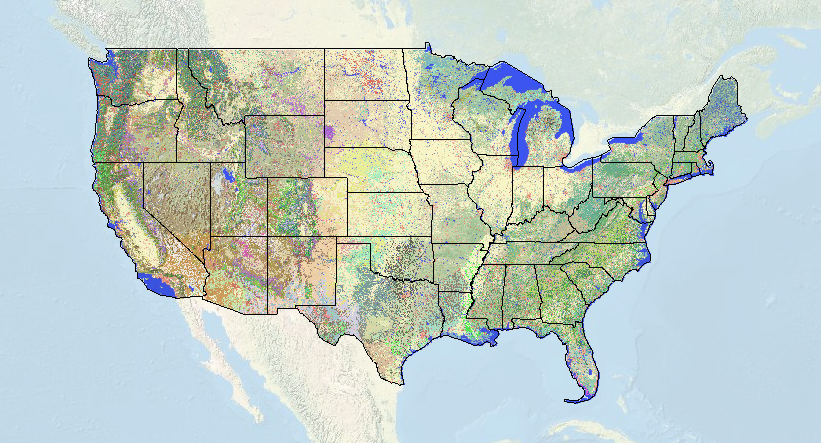
Jag har alltid undrat hur man hittar rätt terminologi för marktäckning inom ett visst område. Vanligtvis, Jag ballpark bara något i stil med “ek chaparral”. Men nu kan jag använda det här enorm ny karta kommer till oss av USGS / National Biological informationsinfrastruktur. Detaljnivån är fantastiskt, och du kan ange graden av precision med en drop down flik (1-3). Nu med en HD-amerikanska topografisk karta jag kan se exakt var de största bestånd av monterrey tall är (egentligen är det en California Coastal Closed-Cone barrskog och skogsmark) så jag kan optimalt placera min fälla i helgen.
Continue reading Landscape Cover Map
Av Chris Grinter, on June 18th, 2010 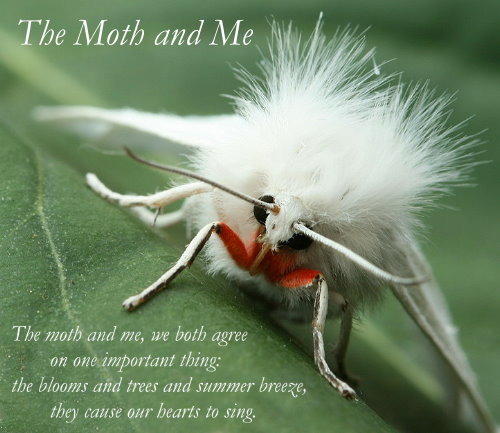
Welcome to The Moth and Me #12, and my first blog carnival. Despite blogging for a few months I have yet to take a look back and reflect on exactly how I became enamored with lepidoptera in the first place. Remembering a time or location where this happened is impossible, and like many of my colleagues and I’m sure many of my readers, I had a butterfly net and “bug cage” in hand as soon as I could walk. When it comes to entomology I believe almost everyone falls in love at first with a large and striking insect. For me it was a butterfly, naturally. I can remember staring for endless hours at the diversity of Ornithoptera and Papilio illustrated in Paul Smart’s famous book. Somewhere along the way in pursuit of something new I began to stray into the nocturnal world. Moths comprise the majority of the diversity of Lepidoptera; while there are nearly 11,000 species in the United States, only a few hundred are butterflies. This quickly opened a door (maybe into an abyss…) to the shocking abundance found everywhere around us. This amazing diversity has now drawn me deep into the biology and evolutionary history of the Lepidoptera. Editing these fourteen contributions of moth blogging together I just can’t help but to reflect back on some of my own mothing journey.

Perhaps if I was a child in Europe this moth (Deilephila elpenor porcellus) would have been the first to catch my eye. Over at Urban Moths Ron Laughton has discovered the stunning diversity in his own back yard in much the same way as I did growing up here in the US. Take a look at the types of traps he has been using, most of which he constructed himself. One of the best behaviors of moths is their willingness to dive headlong into the light. Not too far from Ron, Mike Beale has been blogging british moths as well. It can be pretty amazing just how similar our two faunas are (a few moths actually are the same).
Continue reading The Moth and Me #12
Av Chris Grinter, den 11 juni, 2010 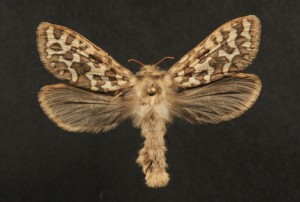
Denna mal är nästan lika sällsynt som den paranormala namne (förutom att det är på riktigt) – det är en Gazoryctra sp. i familjen Hepialidae. De representerar en basal stammen av Lepidoptera och är allmänt känd som spöke nattfjärilar eller snabba nattfjärilar. Ghost – eftersom hanar av vissa arter är kända för att flyga i riktiga Leks, där de svävar upp och ner i gräs hyggen i skymningen medan honorna observerar. Samma män kräver också kvinnor med feromoner, lite av en bakåt situation med insekter. Swift- ganska självklart, men boreala arter har varit kända för att vara kraftfulla flygblad.
En av de funktioner som hjälper indikerar detta som en basal härstamning är placeringen av vingarna på kroppen, några vinge venation, minskade eller frånvarande mundelar och avsaknaden av en stark vinge kopplingsanordning. Dessa malar har en “Range”, som är en liten tumme liknande utsprång från toppen av hindwingen. Andra linjer av nattfjärilar har en stram kopplingsmekanism som kallas frenulum och retinaculum, där borsten haka de två vingarna ihop så de förblir kopplad under flygning. När vila i jugum viker runt och förmodligen hjälper till att hålla vingarna ihop – men inte under flygning; forewingen är ur synk med hindwingen och flygningen inte dynamiskt (Scoble 1992).
I Amerika Hepialid biologin är mycket dåligt känd. Endast en handfull livshistorier beskrivs globalt – vilka alla verkar vara endophagous (tråkig) i växt rotsystem. Några tidiga stadiet larver kan mata i löv eller tunnelbana på rotsystemet innan rotstocken. Australien är lyckligt lottade att ha en rik och imponerande fauna Hepialidae – många är färgsprakande och enorma (250mm eller upp till 12 tum!), och lite bättre studerad. Vissa larver är nog även vanligt att aboriginska stammar har använt dem som en basföda källa.
Men tillbaka till denna mal i synnerhet. Jag samlade det i min svarta ljusfälla i augusti upp i Sierra Nevada runt 10,500 fot. Arten är okänd, och kan troligen vara nya. Det mest frustrerande är att det är det enda exemplaret kända för vetenskapen. Hela släktet är mycket sällsynt, med undantag för en eller två ofrälse arter, bara några tiotal exemplar existerar. Så det är en hona av en art bara beskriven från en manlig? En underlig aberration i en annars kända arter? Eller kanske det är faktiskt nytt. Jag har barcoded DNA, som faktiskt säger mig ingenting eftersom det finns noll sekvenser från några närbesläktade arter. Faktiskt, så vitt jag vet, andra arter i Sierra har inte ens samlats i decennier så jag kan inte ens få en sekvens från en äldre exemplar. Som grädde på moset är deras beteende. De sällan, om någonsin, framkommit – vilket kan vara ett resultat av deras crepuscular flygning. På höger natten kan de vara på vingen för 20-30 minuter, oftast en kvinnlig söka ut en manlig, eller en kvinnlig flyger till oviposit (sannolikt bara sända sprider sina ägg på marken). Så kom det här slutet av augusti kommer jag att återvända till den höga Sierra med några volontärer från entomologi avdelningen i hopp om att se en expert av mig på de branta sluttningarna. Om jag får lite mer, det kan visa sig vara imponerande nya arter för California.
Av Chris Grinter, den 11 juni, 2010 Who can see what’s wrong with this article?

Av Chris Grinter, on June 9th, 2010 
This recent article in the American Naturalist has taken a second look at some of the famously inflated species estimates, some going high as 100 million (Erwin, 1988). Estimates conducted by the authors indicate that projections above 30 million have probabilities of <0.00001. Their estimated range is more likely to be between 2.5 och 3.7 million species (with 90% confidence). This seems somewhat reasonable given that these extraordinary estimates were based heavily on extrapolation. There are clearly many difficulties in assessing diversity based on tropical arthropod surveys – this paper again uses phytophagous (plant-eating) beetles for estimates. They are careful to point out that these methods do not account for non-phytophagous insects, but assume that they will follow traditional biogeographic patterns of diversity. This is somewhat of a new concept given that when I was in college I was taught that parasitoids are counterintuitively not more diverse in tropical regions. This hypothesis is more often than not being proven false in the light of more precise modern taxonomic methodology. Rather proudly I helped play a role with the parasitoid project at the UIUC. I korthet, host specificity is more extreme in tropical environments with hundreds of cryptic species hidden amongst rapidly radiating groups such as the microgastrine Braconids (Hymenoptera) – the same has held true across similar taxa.
One interesting note about the paper is their inclusion of a secondary estimation based on Lepidoptera canopy assemblages. They assumed that a) all Lepidoptera can be found in the canopy and b) that all leps are phytophagous. This is clearly a very conservative estimation given that not all Lepidoptera are found in the canopy and not all are phytophagous. While I do not have the numbers on hand, a certain percentage of lep diversity must have been excluded from these estimates. I will also go out on a limb and assume that the authors (Novotny 2002) did not include microlepidoptera morphospecies – and most likely estimated abundances with our current taxonomic understanding. However I do not have access to this 2002 paper, so I may be incorrect. Using these Lepidoptera numbers (from the same survey as the Coleoptera) a global diversity was estimated by Hamilton et. al. at around 8.5 millions arthropod species.
While I agree that extraordinary estimates of tens of tens (or hundreds) of millions of arthropod species are probably ridiculous; I am of the camp that current research is indicating that estimates of the lower tens of millions of species are possible. The authors have failed to include research that counterbalances their premise that tropical species exhibit a lower beta diversity (Novotny 2002, 2007). In the same journal, Nature 2007, Dyar et. al. have indicated that the American tropics exhibit a higher beta diversity than previously assumed. Either it can be said that estimates of beta diversity in the australasian tropics are incorrect, or they are incompatible with species assemblages of neotropical forests. All of this speaks to the difficulty in extrapolating estimations of species across all tropical regions. These estimates are based on comprehensive insect surveys of New Guinea, perhaps they do not accurately reflect the true diversity of American tropical forests, and these number ranges are low.
As a final thought, most assesments are focused on tropical arthropods. It seems all too possible that the total number of all species, including bacteria and archaea, can easily exceed tens of millions. But extrapolating those numbers is even more precarious than arthropods, given the extreme lack of knowledge we have.
Av Chris Grinter, on June 4th, 2010 
Can’t find a way to link the direct video (not even VodPod), but here is the link to the Daily Show site. How many physicists pulled their hair out when they heard this one? Yikes, he is the newly appointed spokesman. Don’t worry Neil, you’re not going anywhere after this.
Having not aired yet I can’t tell exactly how apologetic the show är, but it seems heavily focused on finding the “creator”. I can hear it in John Stewart’s voice when he pulls back from ripping into Freeman’s “god of the gaps” theory. Perhaps there was an edit and we missed the question where John Stewart asked “Morgan, can you define a logical fallacy for us… perhaps the god of the gaps one?” I believe that any physicist who ever says “god was responsible” says it with no deeper meaning than when Einstein famously evoked god’s dice. That’s to say, a non-literal and non-personal god found only in the beauty and splendor of nature.
Av Chris Grinter, on June 2nd, 2010 
If there is one thing that I learned in college, it was how to easily distract myself. I tend to keep my TV on in the background while I’m working on my computer, especially late at night when I am usually fighting a winning war against sleep. The other night something did catch my eye: a man holding dowsing rods in his back yard. Volume up, let the bullshit flow. It was just a flash of idiocy in an otherwise good program on home improvement. I’ve become accustom to crap-based TV on networks such as the History Channel or a Discovery network (quality of their shows include gems like “The Haunted: ghosts and pets”), but I was a little surprised to see BS grace my local PBS station.
Over on the “American Woodshop” host Scott Phillips was constructing a beautiful garden arbor. You can watch the entire thing here for free: Episode 1609: Period Architectural Moldings and Trim. There are no time stamps on the clip, but the dowsing comes in around the mid-point. While demonstrating the materials needed to secure the wood to the ground he cautioned against digging haphazardly into your yard without knowing where the underground water, electrical or gas lines were: solid advice. So in order to do this you should (paraphrased) “take pieces of coat-hanger, anything will do, turn them into an “Den”. As I walk forward the bars cross – där (they cross) – right there is the irrigation line. 9 out of 10 people have this ability, but you should call in a professional if there is any doubt“. My translation “OK guys, don’t worry about calling in some guy to do this, figure it out this way”. Please tell me what man who seriously watches a home improvement show at midnight would cede authority to someone else before giving it the good ol’ college try? Even if we grant for a moment that 9 out of 10 people could do this, what about that one guy who can’t? Isn’t it irresponsible to suggest that you can avoid power/water/sewer/gas only 90% av tiden? Hoppsan, hit that pesky gas line…
Being a scientist, a skeptic and a procrastinator – I wrote Scott a message about this so I could avoid my work at hand. Today he kindly replied saying: (excerpt)
“Our bodies are electromagnetic fields. Disrupt a field and things happen…. I learned the technique mentioned from a city worker that they used to find lines. Not from a charlatan. My team witnessed the objective use of this technique.”
Briefly, no, our bodies are not electromagnets. Everyone can hold a compass, or TV… without screwing them up. Franz Mesmer coined the idea of “Animal Magnetism” in the last half of the 18th century (also invented “mesmerization” AKA hypnotism) – and had it abruptly debunked by Benjamin Franklin and others. I’m also a bit worried to hear that city workers are relying on dowsing to locate public lines! But to move onward, let us dig into the myths of dowsing. I agree that there seems to be somewhat of an intuitive truth when it comes to dowsing, however false it is scientifically, it remains compelling. Visst… electrical things underground effect sensitive wires above. And wow, look at all these guys who can find water, or power, eller… lost people… eller bombs? OK, let’s stick to water for this conversation.
(continued)
Continue reading An Uphill Battle
Av Chris Grinter, den 1 juni, 2010 Bara några bilder av vanliga Kalifornien leps, längs kusten intervall nära Santa Cruz för några veckor sedan. Börja arbeta mig igenom några foto eftersläpning…

Euphydryas chalcedona
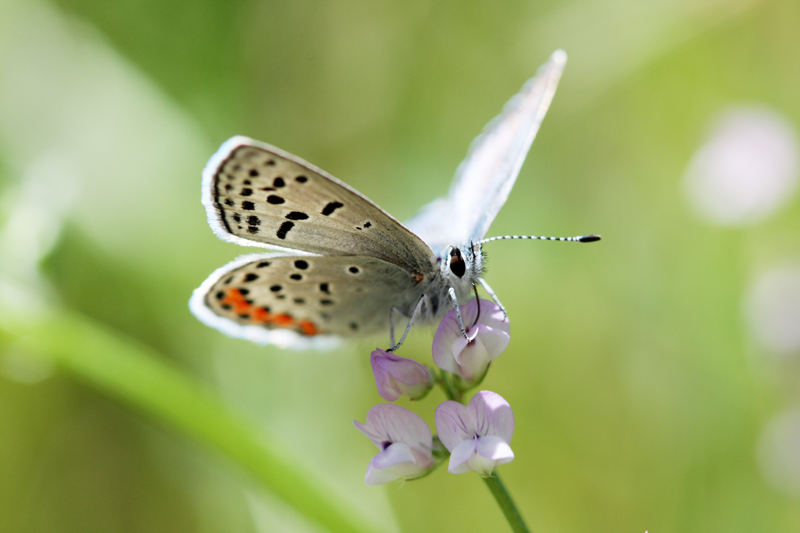
Plebejus acmon
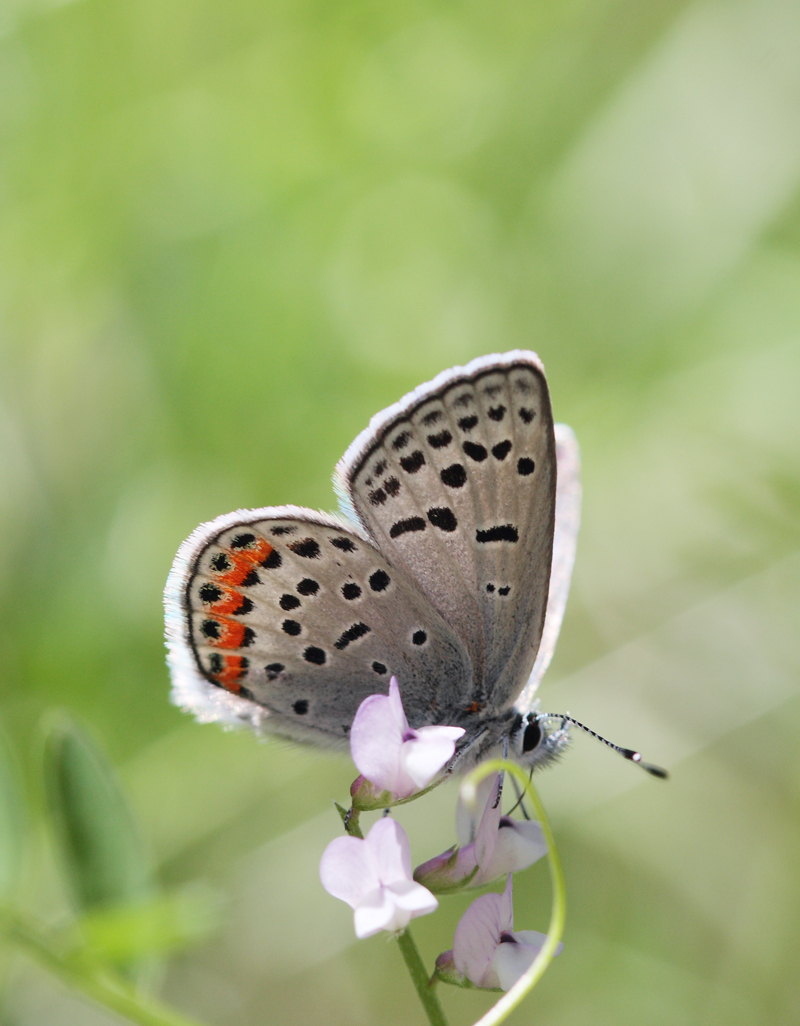
Plebejus acmon

Ethmia arctostaphylella på Eriodictyon sp.
En intressant notering på Ethmia arctostaphylella – namnet är en missvisande, det faktiskt inte livnär sig på Arctostaphylos (Manzanita). Vid tidpunkten för beskrivning i 1880 Walsingham hade hittat larver pupating på blad av manzinata och antog att det var deras värdväxt. I Jerry Powells fantastiska monografi av gruppen visar han denna mal fostrades från Eriodictyon – som råkar vara blomman fjärilen är uppe på. De två växter växer sida vid sida, och det är ganska lätt att se hur en vandrande larv finner sin väg till en granne.
|
Skepsis
|













